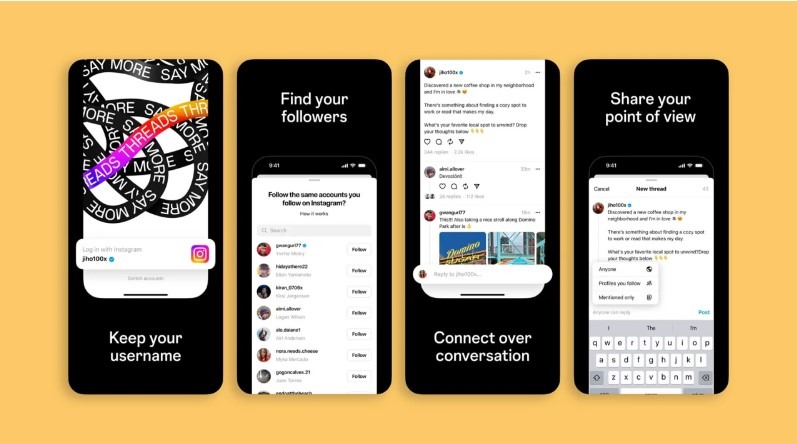Last month, it looked as though Elon Musk and Mark Zuckerberg were headed to a cage match after the owner of Twitter seemed to challenge Facebook’s founder and CEO to a fight, and the latter accepted. That came in response to a tweet asking Musk about Zuckerberg’s planned Twitter competitor, called Threads.
Now, however, it looks as though we’ll have to settle for a battle of the platforms, with Instagram Threads launching tonight, a day earlier than expected. Calling it a Twitter competitor might be underselling the impact the new app could have. In reality, I imagine it’s more likely to be a Twitter killer.
I know it seems a little dramatic to predict the end of Twitter, especially after all the things Musk has done–many of which seem to be trying to get as many people as possible to stop using his overpriced new toy–and yet Twitter hasn’t gone away.
Of course, the past week has been especially rough for Twitter, with Musk saying that the company is implementing rate limits that restrict the total number of views users are able to see in a day. In fact, if Threads does put an end to Twitter, it’ll be less about Zuckerberg capitalizing on the chaotic state of Twitter, and more about how we got here in the first place.
Specifically, there are three reasons Threads might be the end of Twitter:
Expectations Are Everything
One of the biggest problems for Twitter is that people have no idea what to expect. At any given moment, it seems as though the company is making changes entirely based on whatever Musk is thinking. Not only that, the explanations for various changes don’t always make sense.
One of the main reasons the people who have stopped using Twitter have fled to alternatives is that they don’t care for the decisions Musk has made and the chaos that has ensued. People crave certainty, and nothing about Twitter is certain right now.
That doesn’t mean there aren’t problems with Threads: For example, in the iOS App Store, you can check out Threads’ privacy nutrition label. The short version is, it’s collecting all the data–just like Instagram or Facebook. It’s as if whoever filled out the form with the app submission simply chose “Select All.”
That’s definitely not great, but it’s exactly what you might expect from Instagram and its parent company, Meta. It’s a platform based on showing you ads based on what it thinks you like. Privacy is not going to be a thing on Threads.
Look, I’m not a Facebook apologist by any means, but I do think there’s something to be said for a company being up front about who it is and what it’s trying to accomplish. At least you know what to expect.
More important, however, if you like Threads, you can be reasonably sure that it will continue to function as you expect it to for a while. I’m sure Meta will continue to develop the product, and sometimes it will make changes people disagree with, but for the most part, you’ll know exactly what you’re going to get.
The Scale Advantage
For people who wanted something like Twitter, but couldn’t bring themselves to keep using the Musk-owned version, the biggest problem with almost every alternative is that they lack the network effect. There just aren’t nearly as many people using Mastodon, Bluesky, or Post.news.
If the thing you liked about Twitter is that all the people you wanted to hear from were there, that’s not necessarily the case for all of the other options. Some people started using Mastodon. Some people are using Post.news. Other people still use Twitter, which still has far more users than any of the alternatives.
That’s not a problem for Threads, which piggybacks on Instagram’s social graph. That’s a big deal considering Instagram has more than two billion active users every month. For comparison, Twitter has around 400 million.
And, since Instagram made it effortless to create an account using your Instagram profile, the onboarding process is infinitely easier than, say, Mastodon’s, which involves a lot of work that most people won’t bother with. It’s not unrealistic to say that–in a short time–Threads will have more users than Twitter and its competitors combined.
Advertiser-Friendly for the Win
Finally, Twitter’s biggest problem is that it has a huge amount of debt compared with the revenue it generates. To make money, Twitter needs advertisers.
It’s taken steps to become more advertiser-friendly after many of them fled post-Musk acquisition. Hiring its new CEO, Linda Yaccarino, was an important step, but it might not be enough. Many brands still aren’t certain whether Twitter is safe.
On the other hand, there isn’t another company on earth better at building relationships with brands and advertisers than Instagram or Meta. It doesn’t seem like it will take much effort to persuade advertisers to shift whatever budget they planned to spend on Twitter over to Threads.
It also doesn’t seem like it would take much of a shift to provide a final blow to Twitter. It can’t make enough just charging users $8 a month for a blue check mark, and it can’t afford to lose any more ad revenue. Ultimately, this doesn’t even seem like a fair fight.
Source: Inc.com



